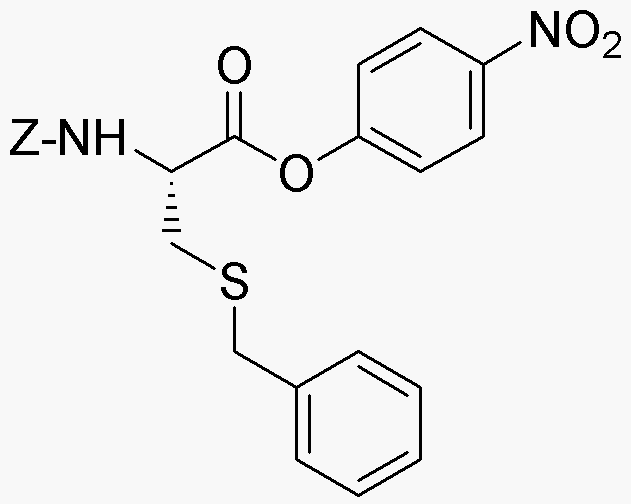Z-S-benzyl-L-cysteine 4-nitrophenyl ester is widely utilized in research focused on:
- Drug Development: This compound serves as a valuable intermediate in the synthesis of pharmaceuticals, particularly in the development of drugs targeting various diseases, including cancer and neurological disorders.
- Bioconjugation: It is employed in bioconjugation techniques, allowing researchers to attach biomolecules to surfaces or other molecules, enhancing the delivery and efficacy of therapeutic agents.
- Analytical Chemistry: The compound is used in analytical methods for detecting and quantifying specific biomolecules, providing essential data for research and quality control in laboratories.
- Peptide Synthesis: It plays a crucial role in peptide synthesis, particularly in the formation of complex peptides that can be used in vaccines or as therapeutic agents.
- Research on Antioxidants: This compound is studied for its potential antioxidant properties, contributing to research aimed at developing new antioxidants for health and wellness applications.
General Information
Properties
Safety and Regulations
Applications
Z-S-benzyl-L-cysteine 4-nitrophenyl ester is widely utilized in research focused on:
- Drug Development: This compound serves as a valuable intermediate in the synthesis of pharmaceuticals, particularly in the development of drugs targeting various diseases, including cancer and neurological disorders.
- Bioconjugation: It is employed in bioconjugation techniques, allowing researchers to attach biomolecules to surfaces or other molecules, enhancing the delivery and efficacy of therapeutic agents.
- Analytical Chemistry: The compound is used in analytical methods for detecting and quantifying specific biomolecules, providing essential data for research and quality control in laboratories.
- Peptide Synthesis: It plays a crucial role in peptide synthesis, particularly in the formation of complex peptides that can be used in vaccines or as therapeutic agents.
- Research on Antioxidants: This compound is studied for its potential antioxidant properties, contributing to research aimed at developing new antioxidants for health and wellness applications.
Documents
Safety Data Sheets (SDS)
The SDS provides comprehensive safety information on handling, storage, and disposal of the product.
Product Specification (PS)
The PS provides a comprehensive breakdown of the product’s properties, including chemical composition, physical state, purity, and storage requirements. It also details acceptable quality ranges and the product's intended applications.
Certificates of Analysis (COA)
Search for Certificates of Analysis (COA) by entering the products Lot Number. Lot and Batch Numbers can be found on a product’s label following the words ‘Lot’ or ‘Batch’.
Numéro de catalogue
Numéro de lot/série
Certificates Of Origin (COO)
This COO confirms the country where the product was manufactured, and also details the materials and components used in it and whether it is derived from natural, synthetic, or other specific sources. This certificate may be required for customs, trade, and regulatory compliance.
Numéro de catalogue
Numéro de lot/série
Safety Data Sheets (SDS)
The SDS provides comprehensive safety information on handling, storage, and disposal of the product.
DownloadProduct Specification (PS)
The PS provides a comprehensive breakdown of the product’s properties, including chemical composition, physical state, purity, and storage requirements. It also details acceptable quality ranges and the product's intended applications.
DownloadCertificates of Analysis (COA)
Search for Certificates of Analysis (COA) by entering the products Lot Number. Lot and Batch Numbers can be found on a product’s label following the words ‘Lot’ or ‘Batch’.
Numéro de catalogue
Numéro de lot/série
Certificates Of Origin (COO)
This COO confirms the country where the product was manufactured, and also details the materials and components used in it and whether it is derived from natural, synthetic, or other specific sources. This certificate may be required for customs, trade, and regulatory compliance.


